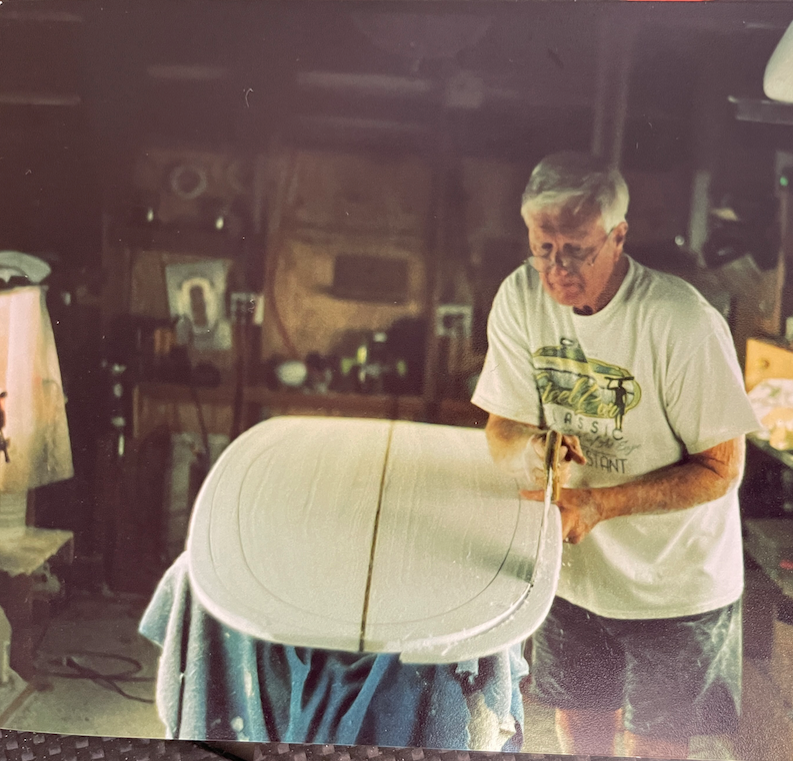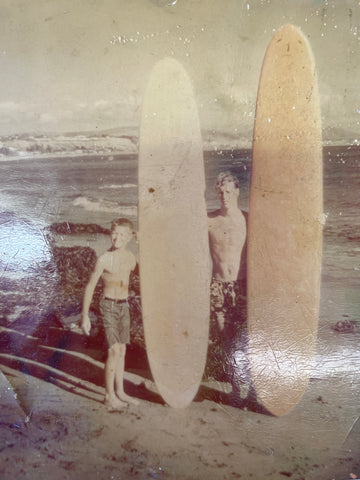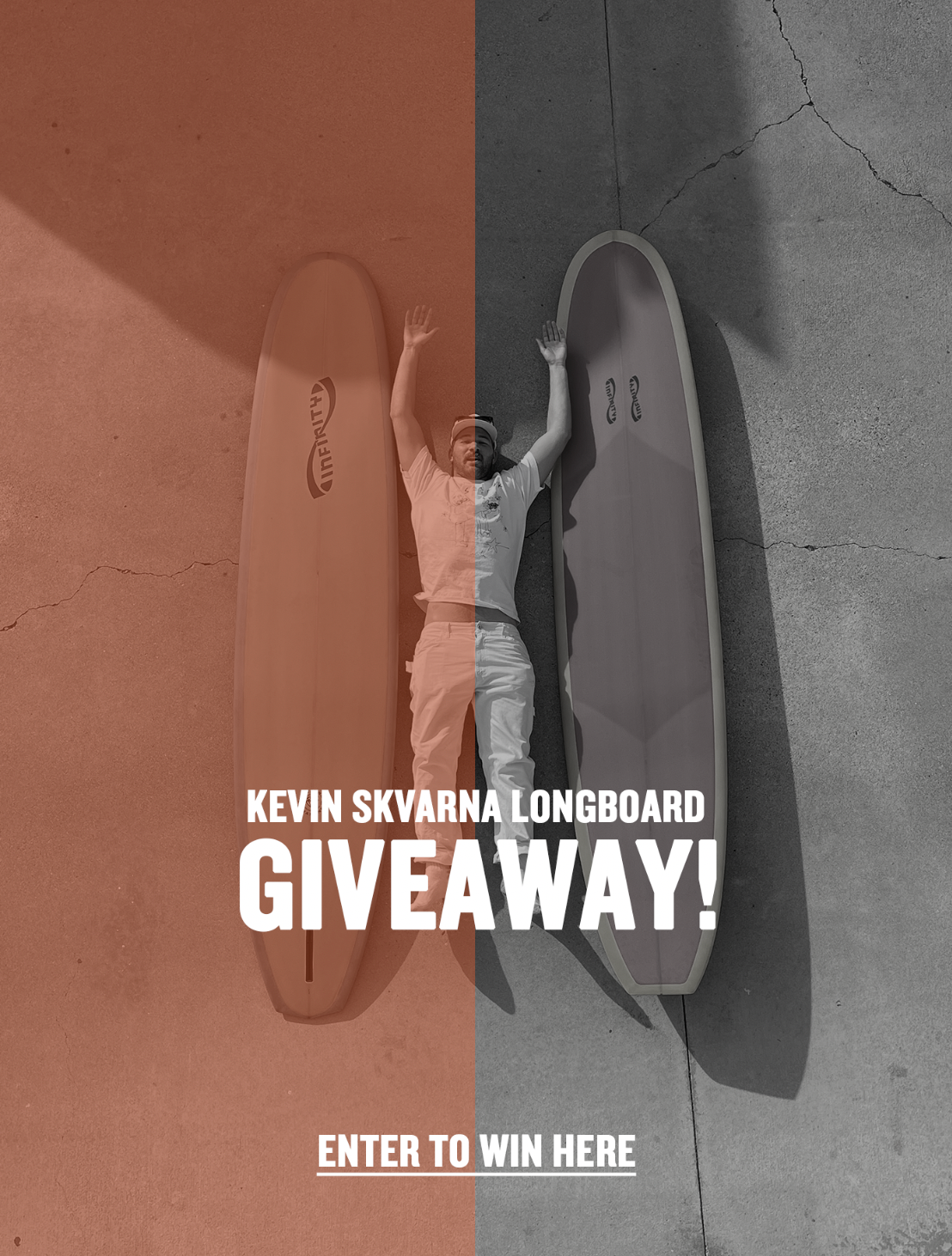60 Years Of Shaping Surfboards

60 years of shaping surfboards
By: Steve Boehne
I first rode a surfboard in 1959 on a balsa wood Velzy – Jacobs. I still vividly remember that first wave, standing up for the fist time and going straight off in the soup. There was a 16 year old guy who lived up the street from me who surfed. His dad was a carpenter and had every kind of tool in the garage, so they began making surfboards. I was up there everyday watching the process. One day they said, we’re going to start another board next week, do you want to make one for yourself with us? So, from this unusual circumstance I am able to claim that I have been shaping since 1960. Later that year, one of my surfing buddies smashed the nose of his board on the rocks at Palos Verdies cove. His dad had a Skil Planner like I saw my friend up the street use. He offered to trade it to me for repairing the nose of his son’s board because he no longer used the planer. So from that day on, I continued to make “Surfboards by Steve” until 1970 when I started the Infinity name.


(photo on the left) is the original board that I made in 1960 + the balsa wood velzy-Jacobs that I gave to my younger brother. (photo on the right) I made this board 2 years later.
As I start this story, I feel a bit like an old musician who has mastered his instrument but can’t quite explain exactly what he does. However, when you listen, you can hear the past, you can hear the depth, you hear the notes bend and the baseline twist. I can only tell you that after running a Skil-planer over foam for sixty years that the same things are going on. I’ve got calluses on my hands that fit around the contour of the depth adjuster on my old skil, just like a guitar player has on his fingertips. As he stretches his strings and bends his notes, adds vibrato, and “grows” a song each time he plays it, I constantly apply combinations of pressures and twists to that old skil-planer to make the blades reach down into the foam behind the nose rocker and up under the tail, or around the rails. I’ve learned how to cut at precise angles, to take microscopic “bands” off the rails to produce a dozen different rail contours for a dozen different styles of surfboards. A good shaper consistently improves his planning and shaping techniques the same as a good musician does.

I look back to how I shaped twenty years ago, after only forty years of experience, and I think; “You fool, you thought you were so hot”. Now I know I can learn even more. I love shaping surfboards, creating a functional sculpture from a blank (shapeless block of foam) is very rewarding. During the process, we shapers are combining multiple slivers of knowledge about our tools, with slivers of knowledge about the particular blank on our shaping rack, with slivers of knowledge from riding generations of surfboard shapes on decades of a variety of waves. We combine rocker, V-bottom, concaves, rail contour, countless outline variations and thickness distribution; we give birth to a surfboard in reference to the guy who has trusted us with his order. As I work, I hear noise, but I feel the sweet sounds of a surfboard blank caressed, and taken beyond itself by me, a musician who can kick butt on his instrument. I guess I’m bragging, but I’m only trying to express how shaping surfboards by hand feels the same as playing a familiar song on a mellow, old Martin guitar; There is pleasure knowing the planer couldn’t have done it without me. You can see that I like to define making surfboards in much the same way as making music. As you listen to a recording, you can be amazed by the raw talent that produced the sounds, but when you look at a surfboard, how do you appreciate all the subtle, unseeable aspects of a shape that supports your weight, and uses the waves energy to project you even faster than the wave itself?
You can’t hear it, maybe you can’t see it, but when you surf, there is a definite personality of performance that each shaper breaths into the birth of a board. You may have learned that you prefer a particular shaper’s boards over others, just as you prefer a certain style of music. This is because each shaper has a certain feel that he likes his board to have as it travels through the water. Over the years, he will grow in his understanding of what to do in his shaping to deliver that feel time after time. His boards will change subtly, but they will become more consistent. There really isn’t a best shaper or best model, it’s more a process of discovering which style of shaping matches the feeling that you like your board to have while you are surfing.
Each generation of surfboard shapers since the beginning of the art has contributed step by step to the point where we are today. Progress was amazingly slow. As we look back, the path seems so obvious. When I started back in 1960, the objective was to make a board symmetrical; the bottom was exactly the same as the deck. Nobody thought about the fact that the bottom of the board planes on the water and the top of the board goes through the air. Rocker was restricted to what you could carve out of a flat 3 ½” thick balsa wood plank. The early polyurethane blanks had very little rocker as well because it took years to realize how more rocker improves performance. A few years back, I asked Phil Edwards, perhaps the most respected shaper of the 1950’s and 60’s, how much rocker he put in his boards back then. His reply was: “I have no idea, we never thought of measuring it”. Today, most shapers precisely measure and proportion rocker very carefully into their boards. Progress was made only as the next generation of shapers rode a board, felt where it held them back, then imagined what needed to be changed: a little more tail rocker, a little more kick in the nose, a curvier template, v-bottom in the tail, a contoured rail with a hard release edge. The changes took so long, it appears that shapers could only observe one aspect at a time. And just like clothing trends, shapers copy each other’s progress. It is amazing, but the evolution in surfboard shapes seems to happen nearly simultaneously around the world. It’s hard to tell the leaders from the followers. Hum, maybe it’s spontaneous, universal creativity.
I would say that nearly monthly, through surfing, shapers become aware of “adjustments” that need to be made to a rocker, outline, rail contour …. that make next month boards just a little better than last months. Now, may I point out that you don’t get this from a molded board or from a board shaped and glassed by a guy in China who doesn’t surf. True, Americans, have not gotten into making molded boards, so if you want a molded board you will have to go overseas. To me, surfboard making; shaping, laminating, sanding, glossing, and polishing, is a noble profession just like any labor trade. Every surfboard tradesman that I know is an accomplished surfer. At the end of a long hard day, you can look at the rack of boards that you have helped create and you feel pride. You see the customer’s name on the order sheet and you know he’s “gonna love” his new board. If you want a handmade surfboard, think about supporting the American surfboard worker. Just like every other job and product that used to be made exclusively in America, surfboard jobs are being exported overseas. Personally, my truck is a Ford!
For years, I have rebelled against shaping machines. Even today, there are few new young guys learning the art of shaping. In a generation, hand shaping skills may be lost forever. This is because now, you don’t even have to copy a hand shape onto a computer, the software lets you create the shape on a screen, press a button and presto: twenty minutes later, your blank is shaped. Does the designer even surf? I can assure you, many don’t! However, how hard can anyone work? What do you do when more guys want your shapes than you can possibly shape by hand? The SUP explosion finally convinced me that I needed help from a shaping machine. Over the first four years of Infinity making SUP surfing and racing boards, I had 100% hand shaped around 1600 SUP boards. This was a monumental task.

Then, my son, Dave meticulously copied every detail of many of these shapes onto the computer. Then with his surfing and racing experience he has created many more great SUP designs. Now I can finish sand one of these computer cut SUP’s in about the same time as shaping a regular surfboard. This allows me the time to return to conventional surfboard shaping. I look at it much as a musician, who can’t play live at every venue, but he can make a recording of his best work so that more people can enjoy his creation.
Most experienced shapers find that fine sanding machine cut boards is extremely boring as compared to creating the shape with their planers. but I find that when I sand a blank that I have designed but was cut on the computer, I don’t mind because I know the roots of its beginning, and I feel a part of this board’s origins. Even though I shape most of our long boards by hand, we do most of our shortboards on the machine because “short boarders” want to know that the model they are getting is exactly the same as the board that the team rider or pro surfer who helped develop it rides. One advantage of the machine; it will “cut” the exact same shape time after time.
Recently though, I have brought back and hand shape two retro shortboard designs that I shaped in the ‘70’s even before Thrusters were invented. It has been fun shaping the old, but modernized designs again. The Sting Fish twin fin has a “double barrel” concave with the center stringer shaped into a keel that extends ½” past the tail giving it a “sting” look. The keel and the concaves give this twin fin more positive steering and projection out of turns.

Early 1970’s version of the double barrel sting fish
The other shape is the Pocket Rocket. Originally, it was a 6 channel, single fin board. Now I have modernized the shape with 3 fins, 4 channels and 4 wings or as a twin fin with double barrel concaves, 2 channels and 2 wings. These modern Pocket Rocket’s are so fast and powerful that they have become a favorite of our local surfers.


Surfers are passionate about their sport, for many, surfing defines who they are. Memories of surf trips to exotic locals and even particular rides sit in our minds just behind our current moment in time. They get us through our forty-hour workweeks. The connection that you have to your sport is your surfboard. The connection that your surfboard has to the waves is your shaper. Every shaper I have ever met believes he is the best; I don’t mean the best technician, I mean the best at producing the kind of board he likes to ride. I truly believe he is right as long as he is as passionate about shaping as you are about riding his shapes.
NOTES: Originally written in early 2000’s Steve Boehne has since been inducted into the International Shapers Hall of Fame in 2014.

